
- Home
- Authenticity
- Genre
- Material
- Style
- Support
- Type
- Acrylique (23)
- Applique (26)
- Coupe à Fruits (52)
- Dessin (65)
- Drawing (23)
- Figurine, Statue (126)
- Gouache (23)
- Gravure (29)
- Huile (135)
- Lampe De Table (74)
- Lampe Tulipe (25)
- Lithographie (35)
- Oil (73)
- Plafonnier (26)
- Sculpture (358)
- Statue (159)
- Statue Sculpture (236)
- Statue, Sculpture (169)
- Suspension, Lustre (116)
- Vase (98)
- Other (1760)
OLD SCULPTURE Art Deco Ceramic DEER Signed LEMANCEAU St Clément
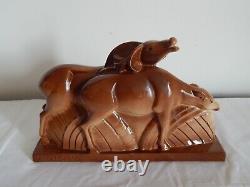
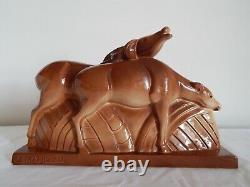
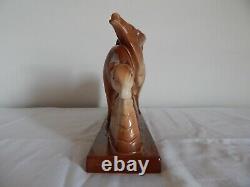
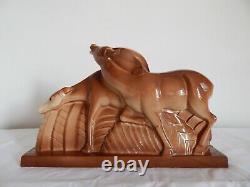



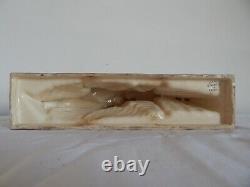
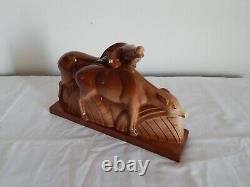


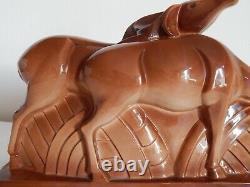


Ancient Art Deco ceramic sculpture. Painted and glazed in brown color representing deer. Signed Lemanceau on the base. Stamp below St Clément Made in France. Dimensions: Height 22.5 cm - Length 35 cm - Width 8.5 cm - Weight 1,400 kg. Born in 1905 in Paris and died in 1980. He was a French sculptor and artist known for his stoneware animal sculptures.
He studied in Paris, graduating from the School of Applied Arts and the National School of Decorative Arts in 1923, after being accepted to the École Estienne and the École Boulle. Starting in 1923, following the "Art for All" movement initiated by Victor Prouvé, he worked for the art workshops of Printemps Primavera, including collaborating with sculptor Chassaing, and creating designs for the Saint-Clément faience factory and the Sainte Radegonde faience factory, as well as for Louis Lourioux establishments.
In 1925, he exhibited at the Salon d'Automne alongside Robert Mallet-Stevens. During his military service, he sculpted the bust of Ambroise Paré for the Val de Grâce.
He then opened a studio in Paris in 1928, where he created the funerary monument of Louis Lourioux. In 1929, he won the ROBJ competition with a life-size decorative nude sculpture. He also sculpted a gazelle in 1930 for "la Maîtrise," the art workshop of Galeries Lafayette, and deer sculptures in 1929 for the Saint-Clément faience factory, catalog No.
1 in the 1930 catalog. He created greyhounds for Pomone, the art workshop of Le Bon Marché, and a cat for Manufrance. He was particularly renowned for his stylized animal forms in crackled enamel.
In 1933, he joined La Ruche and remained there until his retirement in 1967. From 1943, he taught at the workshop-schools of the Paris Île-de-France Chamber of Commerce and Industry, currently known as "ateliers Grégoire," under the direction of Aristide Lomont. Thanks to his fame, he received public commissions, including the tympanum of a church in Vitré in 1943 and the war memorial of Lanvollon. He was awarded a vermeil medal by the Academic Society of Arts-Sciences-Letters in Paris in 1963.
